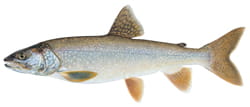
Illustration by Joseph R. Tomelleri ©
Salvelinus namaycush – scientific name
Identification:
(Native Fish) The lake trout has light spots on a black to gray background, which progressively get lighter moving down the side of the fish. The belly is white. The lower fins are often orange to orange-red with a leading white edge. The darker colored back has a dorsal fin and an adipose fin. The tail fin is deeply forked with equal sized upper and lower lobes. The anal fin has 8-10 rays with a leading white edge.
Fishing:
Lake trout prefer cold water and are often found at significant depths, though they can be taken in relatively shallow water in spring and fall. For the most part, lakers are caught by trolling anglers using spoons, flashers and flies or cowbells and minnows, often near bottom. Lake trout spawn in the fall, often on shoals and reefs but some migrate upstream creating angling opportunities on piers, where anglers fishing with spawn, smelt or minnows on the bottom or casting with spoons can sometimes connect. Similarly, short-term fisheries are created in the drowned river mouths just inshore of the Great Lakes and in rivers, where lake trout often are caught incidentally by steelhead fishermen. In the winter months, anglers fishing deep water in Great Lakes bays with spoons or jigs tipped with cut bait take lake trout through the ice.
A number of inland lakes have been stocked with lake trout or have natural populations that produce excellent fishing all year long, typically for those who are adept at Great Lakes tactics. Higgins, Elk, Torch and Crystal Lakes are among of the better-known inland lake trout waters.
Review Fishing Guide for current rules and regulations »
Diet:
The lake trout, as adults, feed primarily on other fish. The native prey includes ciscoes and sculpin, but when available lake trout will take advantage of alewives, smelt, gobies or other fish and sometimes take crustaceans, terrestrial insects, plankton, even small birds and mammals.
Life history:
Lake trout are fall season broadcast spawning fish on shoals or shallow reefs. They do show homing behavior and will return each year to the same spawning area. The eggs are deposited after dark, among the cobble and gravel of the lake bottom. Young lake trout will hatch from the egg and stay among the cobble substrate as sac fry. As swim-up fry stage occurs in early spring, they will emerge from the protective rocky substrate to feed on their own. Lake trout become sexually mature at 6 or 7 years of age. The average adult weighs 9 to 10 pounds but some individuals weigh up to 50 pounds (state record is 61 pounds, 8 ounces). Their life-span may exceed 25 years.
Background information:
It can be found in all five of the Great Lakes and many large, deep, cold water inland lakes of Michigan. The lake trout prefers water temperatures between 40-55 degrees Fahrenheit. In the fall, winter and spring seasons this fish may be found in shallow water areas of the lake, 10 to 30 feet deep. As near shore waters warm in the summer, it follows the cold water temperatures to depths of 100 to 200 feet or more. In the Great Lakes environment lake trout will often range many miles in search of prey.
Over commercial fishing and the introduction of the parasitic sea lamprey severely reduced the lake trout populations in the Great Lakes from 1935 to 1965. Later, chemical contaminants may have also contributed to reproduction problems. Now with better fisheries management, control of the sea lamprey, and solving pollution problems, the stocks are coming back.
Lake trout can successfully hybridize with brook trout to form “splake”. This can occur naturally or more commonly in hatcheries by fertilizing lake trout eggs with brook trout sperm. Splake will live for 5 or 10 years and can reach 16 pounds in weight.











































